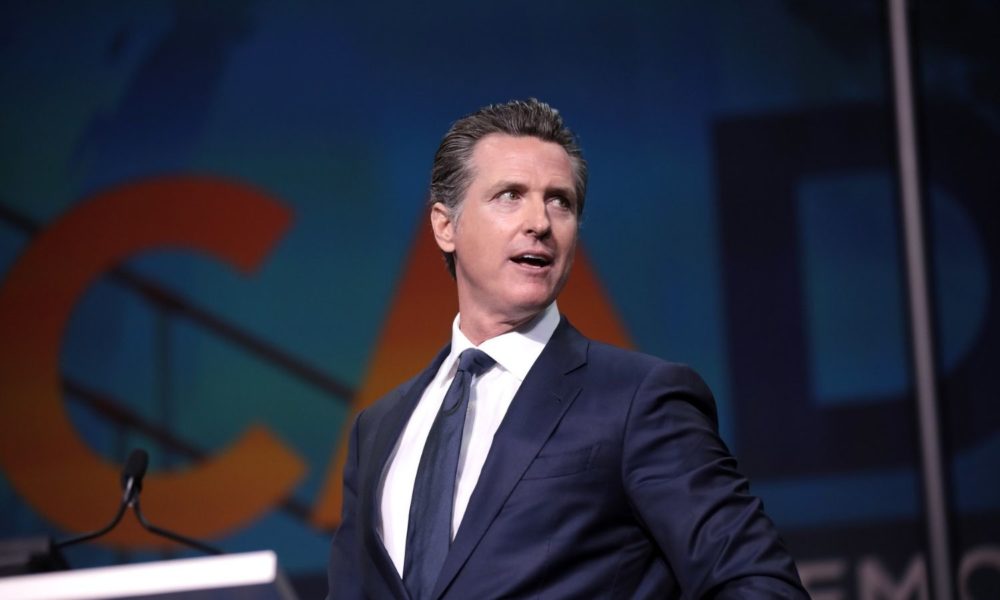California Governor Gavin Newsom has survived the recall election that would have abruptly ended his term in office. Now he has less than 14 months before the 2022 general election in which he’ll face voters again. What should Gov. Newsom prioritize over the next year? With humanity experiencing the unignorable effects of a changing climate, and strong public support from Californians for aggressive action, the answer is clear—the climate crisis.
But what exactly can the governor do in just 14 months to tackle climate change and help restore California’s leadership on the issue? Here are five ways he should start.
1. Expedite California’s transition to 100% clean electricity
Three years ago, Governor Jerry Brown signed legislation committing California to achieving 100 percent clean electricity by 2045. This was a significant step for California, but a lot has changed these past three years. Then California was the second state (after Hawaii) to adopt legislation to require a full transition to clean electricity. Today California is one of 18 states with such commitments (plus the District of Columbia and Puerto Rico), and many jurisdictions are moving more aggressively than California’s timeline. This summer, Oregon lawmakers approved a bill to transition to 100 percent clean power by 2040, and the City of Los Angeles committed to a much faster transition than California, approving a plan to power the city entirely with clean power by 2035.
There are real challenges to powering an electricity grid entirely with carbon-free resources, such as ensuring grid reliability with a diverse mix of clean resources and building enough transmission capacity to carry clean energy from where it is produced to where it is used. However, these challenges are solvable and, quite frankly, must be solved before 2045 to adequately address the climate crisis. Gov. Newsom has already suggested that he believes California can reach 100 percent clean electricity faster than current law, and CalEPA Secretary Jared Blumenfeld recently said that Newsom supports reaching 90 percent clean electricity by 2030. Before Newsom faces voters next year, I hope he’ll seize this moment to expedite California’s transition to 100 percent clean electricity.
2. Pass regulations to require all new cars and trucks to be electric by 2035
In September 2020, Gov. Newsom charted an ambitious path to transition to zero-emission cars and trucks in California via an executive order that called for all new passenger cars and trucks to be zero-emission by 2035, and all medium- and heavy-duty vehicles in operation to be zero-emission by 2045. In 2022, the California Air Resources Board (CARB) will be voting on two regulations that are key to making these goals a reality. The first is the Advanced Clean Cars 2 regulation, which includes the Zero Emission Vehicle program. That program should require automakers to sell zero-emission vehicles equal to about three-quarters of sales in 2030, on the way to selling only zero-emission vehicles by 2035. (For context, California has now reached over 10% of new car sales being zero-emission this year.)
The other key vote at CARB in 2022 will be on the Advanced Clean Fleets program. This rulemaking, which continues the momentum started by a 2020 regulation to require the production and sale of electric trucks, will require owners of medium- and heavy-duty truck fleets to purchase an increasing share of electric trucks. These trucks run the gamut from delivery vans to large 18-wheelers. A strong program would ensure all truck sales are zero-emission by 2035.
It will be up to Gov. Newsom and his appointees at CARB to ensure these rules are ambitious, effective, and implemented without delay. In addition, there will be important opportunities in the next year to expand California’s commitment to deploying equitable and accessible charging infrastructure as well as consumer incentive programs that are focused on bringing the benefits of electric vehicles to low-income households and communities of color.
3. Get real about what California needs to do on climate this decade
Five years ago, lawmakers passed SB 32, which charged CARB with spearheading a reduction in global warming emissions to at least 40% below 1990 emissions in 2030. (For comparison, the 2030 target equates to a 38% cut from statewide emissions in 2019.) The law’s passage was cause for much celebration among climate advocates, myself included. Fast forward to 2021, and the unfortunate reality is California is probably not on track to meet that goal. For all of the state’s well-deserved acclaim for addressing climate change, emissions are simply not declining fast enough at current pace. Moreover, the state’s cap-and-trade program, which the state is relying on for a significant share of emission reductions through 2030, is at risk of failing to deliver the necessary reductions in pollution; in short, the problem is that regulated industries are holding onto a surplus of pollution permits for future compliance with the program.
All of this is cause for concern. However, CARB would disagree with the assertion that California is not on track, pointing to a 2017 roadmap for emissions reductions out to 2030. This debate will come to a head in 2022 as CARB finalizes an updated roadmap—known as the Climate Change Scoping Plan—for reducing global warming pollution in the state. The question for CARB and, by extension Gov. Newsom, is whether they can right the ship by developing a realistic and detailed plan for meeting California’s emissions reduction goals for 2030. A critical part of righting the ship will be incorporating contributions from environmental justice organizations and other stakeholders who want to make sure the state’s climate actions are improving the lives of the state’s most vulnerable residents.
A more overarching issue for the governor to consider is that California’s existing goals for reducing emissions are, in all honesty, an inadequate response to the climate crisis. By any reasonable calculation, emissions in California and the U.S. have already surpassed an equitable share of the global “carbon budget”—the pollution humanity can emit and keep global temperatures below critical thresholds. Therefore, California should be reducing emissions as aggressively as possible. Gov. Newsom deserves credit for asking CARB to model a path to reach carbon neutrality by 2035, 10 years sooner than the state is currently planning. However, it’s not yet clear what comes next. I would welcome Gov. Newsom directing state agencies to pursue more aggressive reductions. Of course, as we are seeing with our existing goals, the challenge lies in meeting them. And that’s why the Scoping Plan will be an important benchmark for success.
4. Prepare now for worse drought and wildfire
Californians are feeling the effects of climate change, and we know it. We are living through extreme drought and wildfires that are sharpening our sense of what our future lives will be like. As the impacts of climate change become much more perilous with time, we must preemptively implement strategies to adapt and build resilience. Fortunately, this year’s state budget directed much-needed resources to address climate risks, including wildfires, water shortages, and exposure to extreme heat. And the state is scheduled to issue an updated climate adaptation strategy later this year. However, there is still much more to do.
For example, there are no uniform requirements or guidelines for the severity of climate impacts that local government, state agencies, the private sector, or citizens should prepare for. As a result, planning and decision-making processes take varied approaches in determining the range of possible futures we may face. That leaves open the possibility that state and local decision-making will fall short of what is required to enable Californians, especially the most vulnerable residents, to maintain or even improve their living conditions in the face of a dramatically warming world. We saw what happened this past year when neighboring counties had different approaches to managing the COVID pandemic. Similarly, it will cause problems if neighboring jurisdictions approach flood response or heat mitigation in incompatible ways. One solution is to require that state and local governments consistently and uniformly prepare for a future in which global emissions remain high. I consider this the “try for the best but plan for the worst” approach to climate resilience, and I hope Gov. Newsom and his administration embrace it.
There are myriad other actions needed to plan for even more severe impacts of climate change. UCS is particularly focused on preparing California’s water system and frontline communities for climate-induced shifts to our water supply, such as a decline in snowpack and an increased risk of extreme drought. Key actions Gov. Newsom and his administration should take on that front include bolstering implementation of California’s landmark groundwater sustainability law—the Sustainable Groundwater Management Act—and better utilizing robust climate science in planning, decision-making, and management of California’s water resources.
5. Sign these 6 key climate bills into law
The previous four actions were complex. But signing a bill passed into law only takes the governor’s signature. With the 2021 legislative session just concluded, legislators have sent Gov. Newsom hundreds of bills that he must sign or veto by Oct. 10. Many important bills to address climate change failed to pass out of the California legislature—for example, a bill to require the state to reach net-zero global warming emissions no later than 2045 tanked because of strong opposition from the fossil fuel industry and others. But some important proposals made it through and now await Gov. Newsom’s signature. Key UCS-supported bills I’ll be looking for him to sign include:
- AB 525: requires the California Energy Commission to develop a strategic plan for offshore wind turbine development
- AB 970: streamlines local permitting for electric vehicle charging stations
- AB 1346: requires CARB to adopt regulations to transition small off-road engines, such as lawn mowers, to zero-emission technology
- SB 372: creates financing tools for truck fleets to transition to zero-emission vehicles
- SB 500: requires any new self-driving cars to be zero-emission vehicles beginning in 2030.
- SB 596: requires CARB to develop a strategy and targets to reduce global warming emissions from cement production
Carpe diem
The best time to have seriously tackled climate change was decades ago. The next-best time is today. The latest IPCC research affirms that the next decade will determine whether humanity can avoid seriously scary tipping points in our climate. With that in mind, the next 14 months are a huge opportunity. As the most powerful elected official in our state, Gov. Newsom should lean into this moment. Carpe diem, Mr. Governor.

